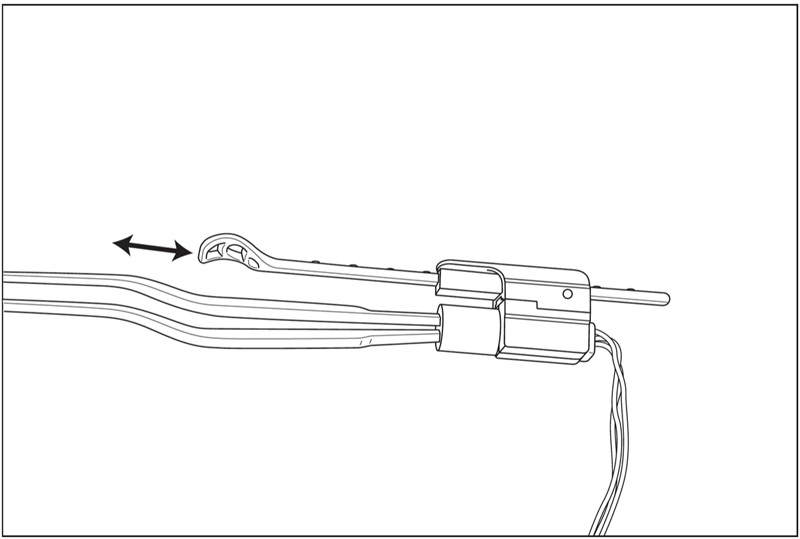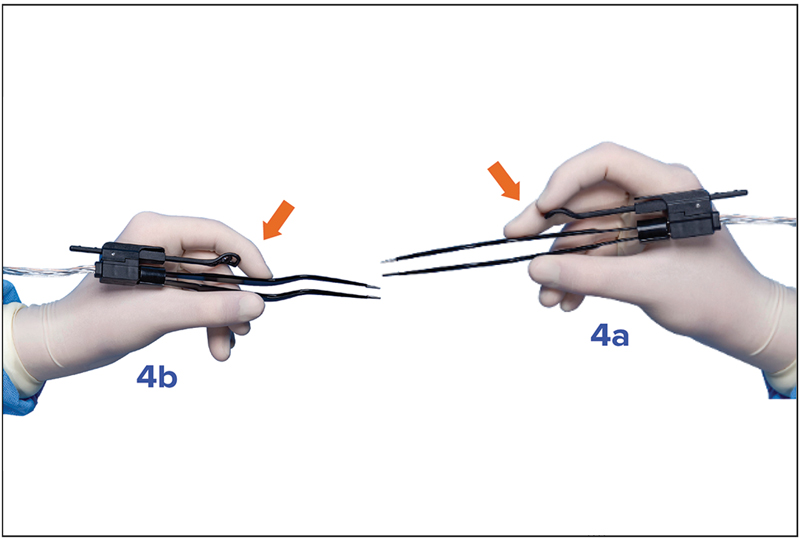Why switch to BiPAD®
Overview
The BiPAD® device is designed to be highly adaptable for every surgical specialty and every surgical scenario. If any surgical situation calls for bipolar electrocautery, BiPAD® hand switch with disposable cords can fill the need.
What is BiPAD®?
The BiPAD® device is a sterile cord with an integrated hand switch that replaces the bipolar cord you currently use. The critical difference is that our cord provides a hand switch for bipolar forceps electrocautery similar to the hand switch found on the monopolar or Bovie® pencil.
Setting up the BiPAD® Hand Switch

Step 01
Attach the BiPAD® disposable cord to your generator.

Step 02
Attach your forceps to “main housing” – adjusting for right or left.
If you are RIGHT-handed, hold the BiPAD® plug with the actuator assembly to your RIGHT and insert the forceps (as in the diagram to right). Vice versa for the LEFT.
The forceps should fit snugly with minimal movement relative to plug when activating hand switch.

Step 03
Adjust the length of the actuator arm.
HOLD the BiPAD® plug with one hand & HOLD the actuator assembly with the other hand.

Adjust the external arm length such that the “mitt” fits comfortably for activation by your finger (4a) – or – touches the space between the distal and middle phalanx (4b).

The external arm can be adjusted by pushing/pulling the external arm through the actuator housing. Clicks will be heard as the arm is moved. Wiggle the arm (front to back) to fully seat prior to use.
Open and close the forceps with the tips of your fingers with out activating. Move your finger inward to activate.
Step 01
Attach the BiPAD® disposable cord to your generator.

Step 02
Attach your forceps to “main housing” – adjusting for right or left.
If you are RIGHT-handed, hold the BiPAD® plug with the actuator assembly to your RIGHT and insert the forceps (as in the diagram to right). Vice versa for the LEFT.
The forceps should fit snugly with minimal movement relative to plug when activating hand switch.

Step 03
Adjust the length of the actuator arm.
HOLD the BiPAD® plug with one hand & HOLD the actuator assembly with the other hand.

Adjust the external arm length such that the “mitt” fits comfortably for activation by your finger (4a) – or – touches the space between the distal and middle phalanx (4b).

The external arm can be adjusted by pushing/pulling the external arm through the actuator housing. Clicks will be heard as the arm is moved. Wiggle the arm (front to back) to fully seat prior to use.
Open and close the forceps with the tips of your fingers with out activating. Move your finger inward to activate.
Quality & Safety
SURGEON EFFICIENCY AND FOCUS
Searching for the foot pedal is time-consuming & distracting. Activating bipolar by hand keeps the surgeon’s focus in the surgical field & uses dexterity of hand versus clumsiness of foot.
SAFER FOR OR STAFF
Having the O.R. staff reposition the foot pedal is time-consuming, distracting & places the clinician on the floor & out of the sterile field potentially exposed to blood-borne pathogens. Our survey data suggests that this occurs an average of 2.4x per surgery.
SAVES O.R. COSTS
Less time searching for the pedal or having the nurse re-position means less O.R. time at $100/minute.
MINIMIZES ACCIDENTAL ACTIVATION OF WRONG PEDAL
Removing the need for a foot pedal to activate bipolar forceps minimizes the chance of stepping on the C-arm foot pedals or other foot pedals under the O.R. table.
REDUCES NUMBER OF CONTAMINATION SOURCES
Elimination of the bipolar forceps foot pedal removes one more piece that harbors potential blood loss born pathogens.
REDUCES BLOOD LOSS
Less time searching for the foot pedal to activate electrocautery means less blood loss.
REDUCES SURGEON & STAFF FATIGUE
Bipolar forceps can be used dozens of times in a single surgery, and looking for the foot pedal every time contributes clinician fatigue.
SAFER FOR PATIENTS
Monopolar electrocautery carries increased risk in patients with pacemakers, CNS stimulators, and other implants.
small change BIG IMPACT
| ESTIMATED TOTAL OPERATING ROOM COST SAVINGS – USA | |
|---|---|
| Time to move pedal | 2 minutes |
| O.R. cost per minute | $50 |
| # of times pedal is moved per surgery (per survey data)* | 2.4 |
| Total O.R. cost obviated by not needing to move pedal during surgery | $230 |
| # of surgeries per year in USA | 50,000,000 |
| % of cases using bipolar electrocautery | 50% |
| Total savings (USA) | $5,750,000,000 |
| ESTIMATED TOTAL BLOOD LOSS REDUCTION – USA | |
|---|---|
| Time to move pedal | 2 minutes |
| Blood loss per minute | 10 cc |
| # of times pedal is moved per surgery (per survey data)* | 2.4 |
| Total cc blood loss per surgery due to time spent moving the bipolar pedal | 46 cc |
| # of surgeries per year in USA | 50,000,000 |
| % of cases using bipolar electrocautery | 50% |
| Total blood loss savings (USA) | 1,150,000,000 cc |
| cc per unit of blood | 525 |
| PRBC CONCENTRATION FACTOR | 3 |
| TOTAL UNITS OF BLOOD LOSS SAVED BY BiPAD® | 730,138 |
*Survey data by BiPAD® Surgical, Inc., BiPAD® Usability Study for Surgeons (V111819), and Usability Validation Report (TR-00003), 1/13/2020.
small change BIG IMPACT
ESTIMATED TOTAL OPERATING ROOM COST SAVINGS – USA
Time to move pedal – 2 minutes
O.R. cost per minute – $50
# of times pedal is moved per surgery (per survey data)* – 2.4
Total O.R. cost obviated by not needing to move pedal during surgery – $230
# of surgeries per year in USA – 50,000,000
% of cases using bipolar electrocautery – 50%
Total savings (USA) – $5,750,000,000
ESTIMATED TOTAL BLOOD LOSS REDUCTION – USA
Time to move pedal – 2 minutes
Blood loss per minute – 10 cc
# of times pedal is moved per surgery (per survey data)* – 2.4
Total cc blood loss per surgery due to time spent moving the bipolar pedal – 46 cc
# of surgeries per year in USA – 50,000,000
% of cases using bipolar electrocautery – 50%
Total blood loss savings (USA) – 1,150,000,000 cc
cc per unit of blood – 525
PRBC CONCENTRATION FACTOR – 3
TOTAL UNITS OF BLOOD LOSS SAVED BY BiPAD® – 730,138
*Survey data by BiPAD® Surgical, Inc., BiPAD® Usability Study for Surgeons (V111819), and Usability Validation Report (TR-00003), 1/13/2020.